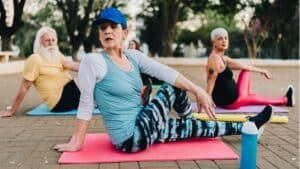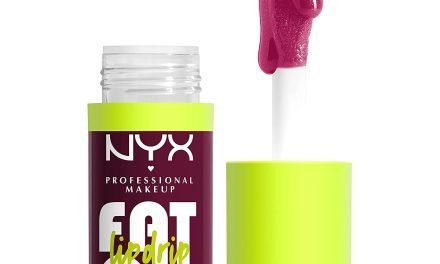
As we journey through midlife and beyond, our approach to fitness needs a bit of a tweak. It’s not about pushing harder or running faster; it’s about getting smarter with our workouts.
Whether you’ve been a lifelong fitness enthusiast or are just starting to incorporate more physical activity into your routine, these simple tips can help you get the most out of your exercise routine during this vibrant stage of life.
Let’s dig in!
Prioritize Strength Training in Your Workouts
While cardio remains important for heart health and overall endurance, strength training should take center stage in your fitness regimen. Why? Because as we age, we naturally lose muscle mass, which can lead to a host of age-related issues such as decreased metabolism, increased risk of falls and sarcopenia. By incorporating strength training exercises into your routine, you’re actively working to combat these issues.
Think of strength training as your armor against the effects of aging. It not only helps in maintaining and building muscle mass but also strengthens your bones, which can prevent osteoporosis. Plus, it boosts your metabolic rate, making it easier to maintain a healthy weight.
This is why Pilates is so popular with women over 50. It is a gentle low-impact workout that feels good, boosts mobility and uses body weight to build muscle and strong bones. If you haven’t tried Pilates, I challenge you to give it a go. It may just change your life!
Other simple exercises like squats, lunges, and lifting weights can make a huge difference. Remember, it’s not about lifting the heaviest weights; it’s about consistency and gradually increasing the resistance as your strength improves.
Ditch the “Go Big or Go Home” Exercise Mentality
Gone are the days when you had to push to your absolute limits every session. As we age, our bodies benefit more from a balanced approach to exercise. The “no pain, no gain” mentality can lead to injuries that take longer to heal as we age. Instead, focus on effective, moderate workouts that keep you moving without pushing you over the edge.
A balanced approach means listening to your body and understanding that rest and recovery are just as important as the exercise itself. It’s about working smarter, not harder. Incorporating activities like Pilates that emphasize flexibility and core strength, can help prevent injuries, improve back strength and overall functionality.
Focus on Consistency Over Intensity
The secret sauce to long-term fitness success is consistency. It’s better to have regular, moderate workouts than sporadic intense sessions. Consistency helps build a sustainable routine, which is key to making fitness a lifelong habit. It was this exact approach that helped me see the results in my own workouts. Adopting this approach is not only more manageable but also more enjoyable.
Think about it: a daily 20-minute walk or a short strength session can be more beneficial than an infrequent high-intensity workout. It’s about making movement a natural part of your daily life. Set realistic goals, and celebrate small victories. Over time, these consistent efforts add up to significant improvements in your health and well-being.
Pilates can easily fit into this consistent approach. Short, daily sessions focusing on different areas of the body can keep you engaged and motivated. Since you only need a mat, Pilates is easily accessible anytime, anywhere.
View Exercise as Self-Care, Not as Punishment
It’s time to shift our mindset about exercise. Instead of viewing it as a chore or a punishment, see it as an act of self-care. Exercise is your time to recharge, invest in your well-being, and show your body some love.
This perspective makes it easier to stay motivated and enjoy your workouts. When you view exercise as a gift you give to yourself, it transforms your entire approach.
Pilates, in particular, is a great form of self-care. Its focus on controlled movements and breathing can reduce stress and enhance mental clarity. As a certified Pilates instructor, I often remind my clients that Pilates is a moving meditation which promotes relaxation and mindfulness, making your workout an enjoyable experience.
Ditch Vanity-Based Metrics and Focus on How You Feel
Forget about the numbers on the scale or the size of your clothes. The true measure of a successful workout is how you feel afterward. Do you feel energized, happier, and more accomplished? These feelings are far more rewarding and sustainable than any vanity-based metric.
Listening to your body and tuning into these positive feelings can help you stay motivated and committed to your fitness routine. It’s about creating a positive feedback loop where exercise leads to feeling good, which in turn makes you want to exercise more.
Simple Shifts for Long-Term Success
Making these simple shifts in your fitness approach can transform your workouts from a dreaded task to an enjoyable and integral part of your life. These changes not only help you achieve the results you’ve been craving but also set you up for long-term success and health.
To help you get started, download my Free Rise and Align Pilates Guide. It includes five simple exercises you can incorporate into your daily routine right away, plus a few bonus goodies (because who doesn’t love free gifts?).
This Pilates Guide offers a gentle yet effective introduction to strength and flexibility training, perfectly suited for midlife and beyond. It focuses on gentle stretching and core activation, which is vital for maintaining good posture and preventing back pain.
Embrace these fitness tips, and watch how small, consistent efforts can lead to big, lasting changes.
Let’s Have a Conversation:
Are you an active person, in your own opinion? Have you tweaked your activities to fit more with your needs after 60? What have you modified and why that particular thing?





